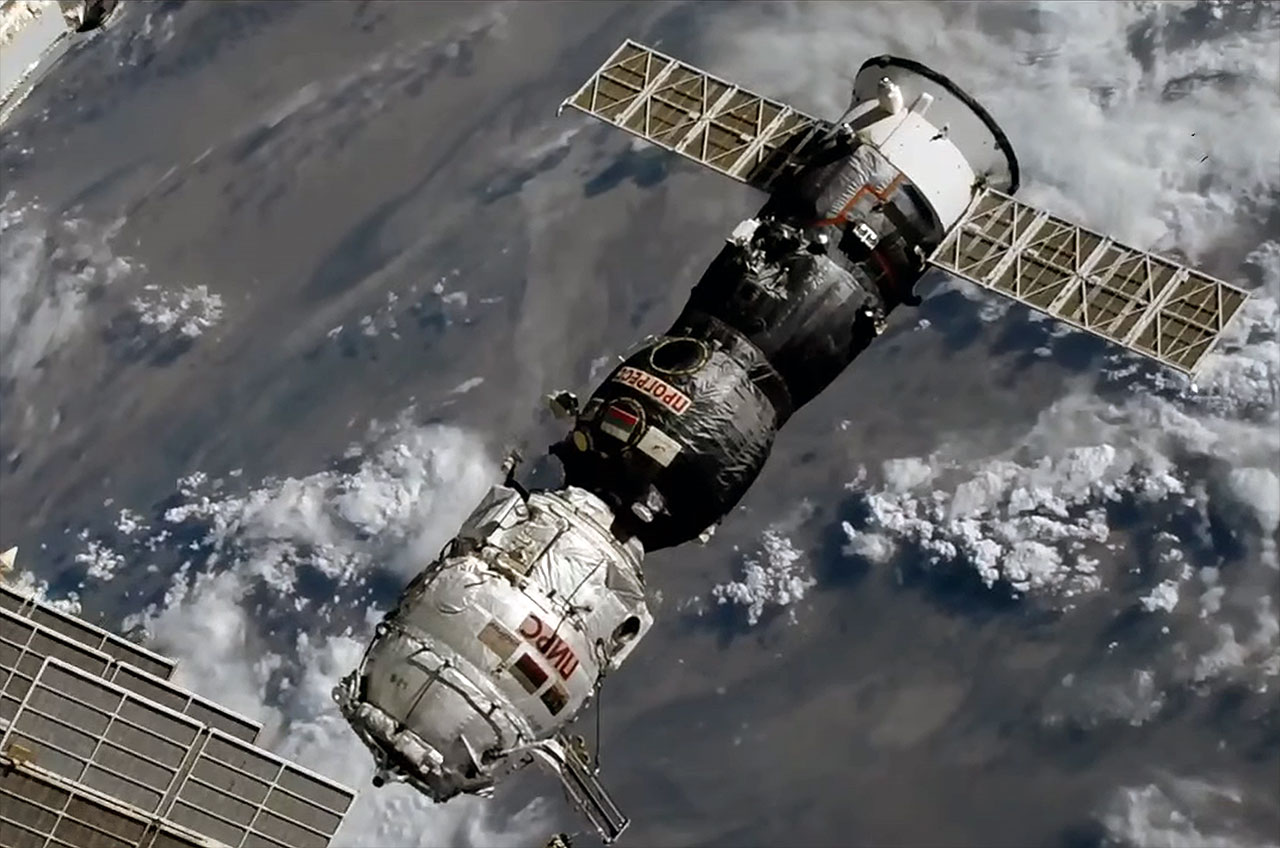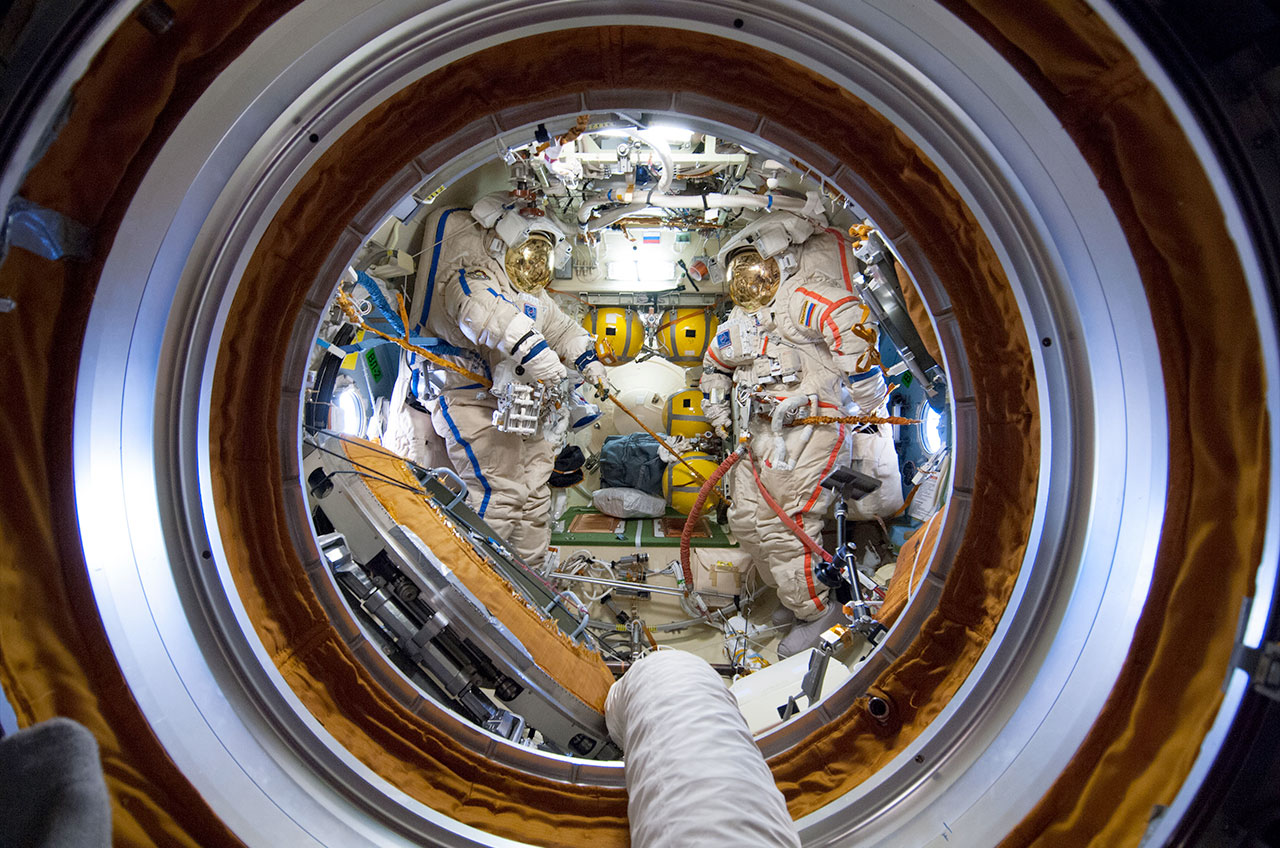Russia discards Pirs docking port to clear way for new space station module
It's been part of the International Space Station for nearly 20 years.
For nearly 20 years, Russia's Pirs docking compartment served as one of the primary ports for vehicles arriving and departing from the International Space Station. On Monday (July 26), though, it was the module's turn to go to make way for a long-awaited, incoming upgrade.
The Pirs docking compartment undocked from the space station at 6:55 a.m. EDT (1055 GMT) and was slowly pulled away by the last Progress cargo spacecraft to dock to it. The departure, from the nadir, or Earth-facing side of the Zvezda service module on the station's Russian segment, marked the first major component of the orbiting complex to be decommissioned and discarded.
The 16-foot-long by 8-foot-diameter (5-by-2.5-m) Pirs, linked to the Progress MS-16 (77P) spacecraft, backed away from the station under the control of the cargo craft's engines. The uncrewed freighter was scheduled to perform a deorbit burn at 10:01 a.m. EDT (1401 GMT), sending it and Pirs back to Earth to be destroyed on their re-entry over the Pacific Ocean about four hours after they left the station.
Related: Skywatcher spots Russia's Nauka science module headed to space station
The disposal came five days after Roscosmos, Russia's state space corporation, launched Pirs' replacement: the multipurpose laboratory module (MLM) named "Nauka" (the Russian word for "science"). Delayed by more than 13 years due to a series of technical issues and budget constraints, Nauka will serve as a research facility, docking port and spacewalk airlock.
The new module, which is based on the design of the station's Zarya functional cargo block (FGB), is scheduled to dock to the Pirs-vacated port on the Zvezda service module on July 29 at 9:25 a.m. EDT (1325 GMT). Russian flight controllers had originally planned for Pirs to undock on Thursday (July 22), but delayed it four days to allow more time to ensure the Nauka MLM was operating in Earth orbit as needed to safely connect to the space station.
The Pirs docking compartment was launched from the Baikonur Cosmodrome in Kazakhstan on Sept. 14, 2001, with a modified Progress as the upper stage of its Soyuz-U rocket. Three days later, it linked up with Zvezda, becoming the sixth pressurized module to be added to the space station.
Breaking space news, the latest updates on rocket launches, skywatching events and more!
Related: The International Space Station: Inside and out (infographic)
Over the past 20 years, more than 70 vehicles docked and undocked from Pirs (which means "pier" in Russian). In total, 39 Progress cargo vehicles and 32 Soyuz crewed spacecraft used Pirs to arrive or depart from the space station.
The first use of Pirs as a docking port was by Soyuz TM-32 on Oct. 19, 2001. ISS Expedition 3 crewmates Vladimir Dezhurov and Mikhail Tyurin of Roscosmos, together with astronaut Frank Culbertson of NASA relocated the Soyuz from the nadir port on the Zarya FGB to Pirs.
Pirs was also used an airlock, supporting 53 spacewalks by pairs of cosmonauts and astronauts wearing Russian Orlan spacesuits. The first extravehicular activity (EVA) out of Pirs, conducted by Dezhurov and Tyurin on Oct. 8, 2001, marked the 100th Russian spacewalk in history.
The final use of Pirs as an airlock occurred on May 29, 2019, supporting an EVA by Expedition 59 crewmates Oleg Kononenko and Alexey Ovchinin. Subsequent Russian spacewalks were performed using the Poisk ("Search") mini-research module to prepare for Pirs' departure by removing exterior mounted experiments, repositioning antennas and re-routing cables.
In total, the Pirs docking compartment had been docked to the International Space Station for 19 years, 313 days, 9 hours, 50 minutes and 45 seconds. From the point of its launch to its expected destructive reentry was 19 years, 315 days, 15 hours, 10 minutes and 56 seconds.
In addition to the soon-to-arrive Nauka, the Russian segment of the station has three other available docking ports: mini-research modules Rassvet ("First Light") and Poisk, as well as the aft port on the Zvezda service module. U.S. commercial crew and cargo spacecraft connect to international docking adapters or are linked to common berthing mechanisms on U.S. operating segment connecting nodes.
Follow collectSPACE.com on Facebook and on Twitter at @collectSPACE. Copyright 2021 collectSPACE.com. All rights reserved.

Robert Pearlman is a space historian, journalist and the founder and editor of collectSPACE.com, a daily news publication and community devoted to space history with a particular focus on how and where space exploration intersects with pop culture. Pearlman is also a contributing writer for Space.com and co-author of "Space Stations: The Art, Science, and Reality of Working in Space” published by Smithsonian Books in 2018.
In 2009, he was inducted into the U.S. Space Camp Hall of Fame in Huntsville, Alabama. In 2021, he was honored by the American Astronautical Society with the Ordway Award for Sustained Excellence in Spaceflight History. In 2023, the National Space Club Florida Committee recognized Pearlman with the Kolcum News and Communications Award for excellence in telling the space story along the Space Coast and throughout the world.




